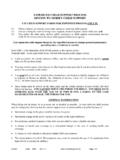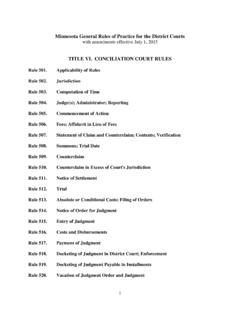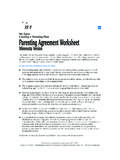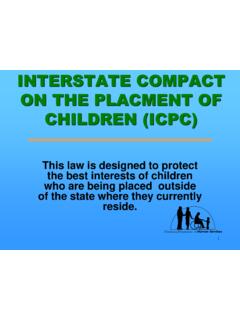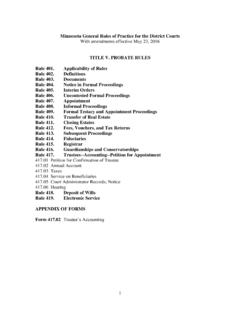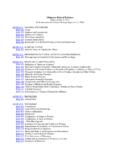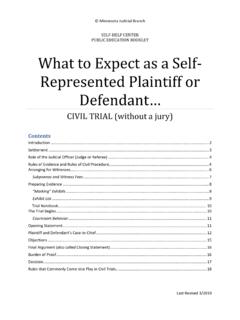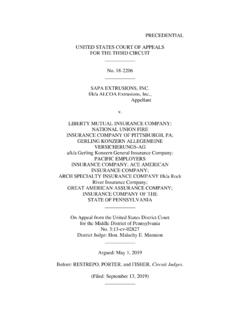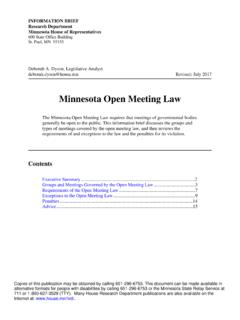Transcription of REPORT TO THE COMMUNITY - mncourts.gov
1 REPORT TO THE. COMMUNITY . The 2018 Annual REPORT of the minnesota Judicial Branch LETTER FROM THE. CHIEF JUSTICE. Dear fellow Minnesotans, I am pleased to present, on behalf of the judicial officers and staff of the minnesota Judicial Branch, the 2018 Annual REPORT to the COMMUNITY . The REPORT is intended to give you a comprehensive view on the work and improvements implemented to increase access to justice in our great state. One of the first promises made in minnesota 's Constitution is the right for all to obtain justice freely.
2 Promptly and without delay. The judicial officers and staff of the minnesota Judicial Branch strive every day to make that promise a reality for all while working to enhance the trust and confidence in our state courts . In this REPORT you will find a summary of efforts made in 2018 to ensure fair and timely access to justice, increase the efficiency and effectiveness of court operations, and improve outcomes for those who enter our justice system. This includes: Growing on the successes of reengineering of our court processes to ensure convenient, consistent, and customer-focused innovations.
3 Expanding on the nationally-recognized tools offered to support self-represented litigants;. Increasing the oversight and review of conservator-managed accounts and support services for guardians;. Updating and making permanent the pilot for cameras in district courtrooms during criminal cases;. Increasing electronic tools to make judicial and court administration more efficient. There were many achievements made by our employees and judges in 2018. The minnesota Judicial Branch is committed to our mission to provide equal access for the timely resolution of cases and controversies.
4 I. hope you find this REPORT informative and useful. Sincerely, Lorie S. Gildea Chief Justice minnesota Supreme court TABLE OF CONTENTS. Letter from the Chief Justice 2. Judicial Branch Overview 4. Strategic Plan 5. Access to Justice 5. Effective Administration of Justice 12. Public Trust, Accountability, and Impartiality 14. District Courts 17. court of Appeals 48. Supreme court 50. Appellate Clerk's Office 57. State Law Library 59. 2018 Annual REPORT minnesota Judicial Branch 3. ABOUT. THE minnesota . JUDICIAL BRANCH. The Judicial Branch Mission To provide justice through a system that assures equal access for the fair and timely resolution of cases and controversies.
5 Judicial Branch Overview There are three levels of court in minnesota : district courts, the court of Appeals, and the Supreme court . District courts are located in each of the state's 87 counties and are divided among 10 judicial districts for administration purposes. The Chief Justice of the minnesota Supreme court is the administrative head of the Judicial Branch and responsible for its overall management. The Chief Justice chairs the minnesota Judicial Council, the administrative, policy-making body for the Judicial Branch.
6 The State court Administrator serves as staff to the Judicial Council. The State court Administrator's Office provides central administrative infrastructure services to the entire Judicial Branch, including human resources, finance, legal research, information technology, communications, statewide program management, and research and evaluation services. The Chief Justice leads the Supreme court , which, in addition to resolving the cases that come before the court , has the responsibility for regulating the practice of law and for the promulgation of statewide rules of procedure and practice for all courts of the state.
7 There are seven justices on the Supreme court . There is a chief judge of the court of Appeals, appointed by the governor for a three-year term, who serves as the head of that court . There are 19 judges on the court of Appeals. One district court judge in each judicial district is elected as a chief judge by the bench for a two-year term, and is responsible for the management of the entire judicial district. The chief judge is assisted by a judicial district administrator. In 2018, the district courts were served by 294 district court judges, 23 referees, and 28 child support magistrates.
8 In 2018 there were 106 Judicial Branch court locations across minnesota . Judicial Branch FY2019 Budget District (Trial) Courts $294,978,000. court of Appeals $12,470,000. Supreme court /State court Administration/State Law Library $38,011,000. Total $345,459,000. 4 2018 Annual REPORT minnesota Judicial Branch STRATEGIC PLAN. STRATEGIC PLAN. Every two years, the minnesota Judicial Council directs a comprehensive strategic planning process that defines the Judicial Branch's major goals for the upcoming biennium, and creates an operational roadmap to achieve those goals.
9 The minnesota Judicial Branch's major goals for the current FY2018-19 Strategic Plan are as follows: Access to Justice Effective Administration of Justice Public Trust, Accountability, and Impartiality ACCESS TO JUSTICE. A justice system that is open, affordable, understandable, and provides appropriate levels of service to all users. The transition from eCourtMN to OneCourtMN has created an opportunity for OneCourtMN Vision court -user-focused organizational changes, process improvement, and continuity of High-quality, consistent, and service experiences.
10 Reengineering has been convenient court administration the strategic effort that has led these wide- services anywhere in the state. ranging initiatives to continue to improve customer experience in the fully digital, eCourtMN. minnesota 's court system. environment. Members of the Committee also formed and led local reengineering committees in OneCourtMN: Reengineering their districts to advise the statewide Committee minnesota 's Courts and build consensus around the OneCourtMN. The Reengineering Steering Committee was vision and direction.
